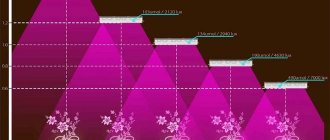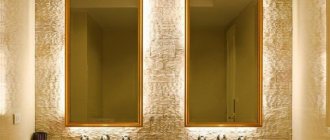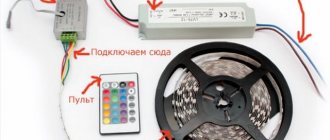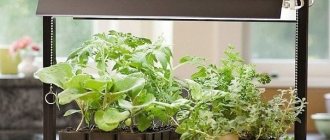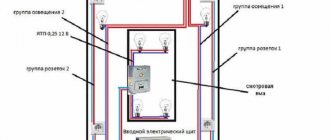It would seem that everyone knows that light is necessary for good plant growth and to obtain a large harvest. Due to light, photosynthesis and other processes occur, which I am not very good at. However, not many people know that plants not only need a LOT of light, but also a certain amount of light!
A huge number of phytolamps, phytolights, etc. are produced around the world. light sources, which are designed for faster and stronger plant growth. But be that as it may, LED strips for plants remain the most common and most in demand. This is due to the fact that the light emanating from this source is uniform, the LEDs are evenly distributed along the entire length of the strip and the plant receives exactly the amount of light that it needs. The same cannot be said about narrowly focused phytolamps. They provide light distribution only in a certain area. In order to completely cover the entire plant you need more than one lamp. And these are additional costs, additional energy, additional unforeseen circumstances.
For those who do not want to delve into the nuances of choosing LED strips for plants, they can immediately choose and buy a strip for every taste and budget. For those interested in the more entertaining part, read on.
—> —>
It is clear that LED strips are far from new devices and are not a novelty. I have already covered issues such as the choice of LED strips, the choice of transformers for them, etc. more than once. Therefore, I will not dwell on them in this article. Those who need it can read it themselves on the website. Or use a calculator to select a power supply for LED strips.
I want to dwell on the technical characteristics of these tapes. Or rather, what kind of light should LED strips for plants have in order to get the greatest effect from their use.
Spectrum of LEDs for plants
In order to understand the necessary spectra for a variety of plants, it is necessary to understand into which parts of the illumination the sunlight is divided. The unit of measurement for any parts is nanometers. Each part of the world has its own length:
- 380 nm and below – ultraviolet part;
- 380-430 nm – violet;
- 430-490 nm – blue;
- 490-570 nm – green;
- 570-600 nm – yellow;
- 600-780 nm – red;
- 780 nm and above – infrared.
Depending on the position of the sun, the component of the spectrum also changes. If the sun is at its zenith, then ultraviolet increases and infrared decreases. Thus, at the zenith, light from violet to yellow will predominate. At sunrise, on the contrary, green and infrared predominate. It is also worth considering the fact that the spectrum will be influenced not only by the location of the sun, but also by various factors - cloudiness, dust characteristics, magnetic storms, etc. Those. it is clear that the sun, despite the fact that it is a measure of illumination, does not always “give” us what we want to receive. Hence, it is clear that a person wants to receive artificial light, which will be as close as possible to the sun and will not depend on various factors.
In general, phytolamps or other light sources for plants are a rather difficult and interesting topic. It is hardly possible to cover all the issues and nuances in one article. But in my case this is not necessary. My goal was to figure out which LED strips for plants are most preferable, how many LEDs for plants should be used and which ones. How to place them. In general, these are fundamental questions that one way or another you need to know if you decide to use LED strip for plants on your farm.
Let's delve a little deeper into plant growing. In particular, what processes are affected by different radiation.
- Ultraviolet radiation, in its own way, has a negative effect on the entire growth of the plant. The leaves turn yellow, the stems curl and begin to hurt. But this can only be observed if we use pure ultraviolet light. In nature, this spectrum is delayed by the ozone layer and practically does not reach plants. This applies to radiation with a wavelength of 280 nm and below.
- Long ultraviolet rays from 315 nm to 380 nm do not give plants growth, but allow the stems to gain massiveness. Plants absorb vitamins well. Radiation at 315 nm helps plants easily tolerate light frosts. This is especially necessary if the plants are late and should bear fruit or bloom in the fall. When it is not yet very cold, but the summer solstice is leaving at a rapid speed.
- Violet and blue rays are ideal for photosynthesis. The plant absorbs more light and grows rapidly. Buds, tubers, etc. set well.
- Green light, contrary to popular belief, has no effect on the “greenness” of a plant. This spectrum passes past the leaves. Photosynthesis is minimal. Due to the green spectrum, the plant stretches and gains growth.
- The red spectrum is the basis for photosynthesis. Using this spectrum allows plants to develop at lightning speed. And this can be easily noticed if you experiment with sunlight and artificial light with a predominance of the red-orange spectrum.
In principle, we can get all this if we grow crops in open ground or a greenhouse. But due to various factors, plants will not develop quickly and painlessly.
It was for the artificial and rapid growth of plants that phytolamps were invented. I have already said about them that they should only be used if the plant is still small. The most rational way is to turn on lamps that will give us diffused light throughout the plant. But again, this all costs money. And not small ones. LED strips for plants can be considered a good alternative. They can be placed vertically along the entire length of the plants and over a large space. The cost is not high compared to conventional lamps and everyone can afford them.
Let me make a reservation right away that LED strip for plants is not a panacea. And I would use them only in the initial stage of plant development. AS you develop, you will still have to switch to lamps and luminaires, which must be selected individually. There is no general solution for phytolighting. For each crop it is necessary to select its own color. It's hard. And no one will just give you this information. But if you can select and experimentally calculate the required spectrum, you are guaranteed to get a quick and large harvest.
What effect do different spectra have on seedlings?
Sunlight consists of rays of different wavelengths. Each type has a unique effect on seedlings. Phytolamps are necessary to artificially extend daylight hours for plants. Each color in the illumination of seedlings affects the plant, promoting their development:
- Red and orange spectrum. These colors play an important role in chemical processes, thanks to them photosynthesis occurs. Red light also helps stimulate seed germination. Under the influence of the spectrum, the sprout begins to straighten and grow upward.
- Blue-violet spectrum. Necessary to speed up the development period. The rays suppress the growth of the stem itself, preventing it from stretching. At the same time, the blue color helps initiate the process of cell division, making the stem thicker. Another feature of the effect of blue color on growing seedlings is the reaction of phototropism, in which the growth of plant cells when blue light enters is inhibited, as a result of which the shoot bends in its direction.
- Green and yellow spectrum. They practically do not take any part in the development of plants. They are reflected from plants, the foliage does not absorb them.
Full spectrum LED strip for plants
For lamps, lamps and strips for plants, not ordinary LEDs are used, but phyto-LEDs, which have an almost full spectrum, which allows them to be used in plant growing.
The most common and suitable (to a greater extent) are full spectrum LED lights for plants. They use red and blue LEDs. The quantity per meter is varied. You need to look at the technical specifications. They produce tapes with a combination of 10 to 3, 15:5 and 5:1. The strips with 5 blue LEDs to 1 red were recognized as the best. A 5:1 ratio should be used if your plants are on a windowsill and have plenty of access to sunlight.
Full spectrum LED plant strips are a universal light source and are suitable for all plants. In reality, I don’t know. I haven't tried it. I only have dill growing on my windowsill. And there is enough light from the tape. the bushes are small but fluffy. Which is exactly what I needed))).
A little about LED design
LED crystals emit almost monochrome light, depending on the semiconductor material. To obtain a yellow, white or the same “full for plants” spectrum of radiation, a phosphor coating is used, which converts primary radiation into secondary radiation using photoluminescence. Typically, such an LED consists of a housing with a substrate and leads onto which the LED crystal, silicone lens, shaping the direction of radiation, a gasket with a phosphor and a protective cap made of transparent plastic.
In this design, the brightest LED crystals with a blue and violet spectrum are most often used. Engineers around the world are struggling to increase light output and improve the spectrum and other characteristics of the LED. Our Chinese friends, hiding behind high technology, are looking for ways to reduce the cost of goods and conquer the market, from banal deception (what are the same Chinese watts worth))), to searching for the cheapest components. In order to understand a little about the market conditions for LEDs for plants, I purchased several sets of 3-watt “beads” from different manufacturers: Expensive Bridgelux LEDs with “full spectrum” LEDs on Epiled chips with “full spectrum”, the cheapest in the review LEDs with Taiwanese Epistar chips with “full spectrum” 440 and 660 nm LEDs with Epistar chips Conventional warm white LEDs used in lighting lamps
At first glance they all look like identical twins)))
But turning on the LEDs revealed an interesting feature. If the Epiled and Bridgelux LEDs behind the phosphor have a 42mil or 45mil square die
Then the Epistar crystal has a clearly rectangular shape
A search on the manufacturer’s website actually showed the presence of 30x43mil rectangular crystals of varying power.
The current-voltage characteristic showed a clear difference between the crystals
The yellow LED showed the greatest voltage drop on the crystal, and therefore the electrical power. The smallest is Epistar. I did not present the characteristics of 440 and 660 nm LEDs here; they can be found in this review. Spectral analysis using a jewelry spectrometer showed that LEDs for plants have characteristics close to those declared
Since I do not have an accurate spectrometer, it is not possible to compare the quantitative components of the spectrum.
To identify the differences, I decided to conduct
Set of LED strips for plants
There is simply a huge variety of LED light sources for plants on the market. For every taste and color. For any wallet. I’ll say right away that there are practically no really high-quality tapes made in Europe. Most gardening enthusiasts purchase tapes from Chinese sites. Particularly on Aliexpress. I also have some experience on this issue. Links to verified stores are available upon request. I don’t want to fill the text with possibly unnecessary links.
I don’t see the point in spending exorbitant amounts of money on “supposedly” genuine Bridgelux, etc. tapes. I can say with one hundred percent certainty that our “sold” products offer no different products from the same Ali. Only in more colorful packaging and promotional material.
There are the most advanced ones that offer separate kits, as a result of which the tape becomes even more expensive in cost.
The LED strip for plants is NO different from the usual one in terms of nutrition. They do not use any special power supplies, special radiators, etc. things that dishonest sellers can sell you on. Be careful. The only difference is that special LEDs with a certain spectrum are installed in the strips. This is where the differences end. Although... Due to the unusual fall on phyto-LEDs, strips for plants are mainly cut into segments of 9 LEDs each, unlike the usual one, where 3 LEDs remain in the segments.
Induction bispectral
Review of the best LED lamps for plants
The principle of operation is similar to fluorescent lamps, however, they differ significantly in design. There are no internal electrodes in the induction lamp, which has a very positive effect on their service life. When used for about 12 hours a day, the lamp can last up to 20 years. Of course, over time, the brightness of the phytolamp decreases, but no more than 5% of the original values. It does not burn out during power surges, does not flicker and does not overheat, thanks to which induction lamps can be placed in close proximity to plants. The light output is as close as possible to natural light, thanks to which these lamps can be used as the only source of phytolight. The main and only drawback of lamps of this type is the very high price.
https://youtube.com/watch?v=gMOd0Uf35EM
LED with E27 socket
Consuming a minimum of electricity, LED lamps provide maximum light. They differ from other phytolamps in their long service life (about 50 thousand hours or more) and minimal heating. They can be compactly placed together with the ballast control unit. Thanks to the standard E27 base, they can be inserted into any lamp, which makes their operation several times more profitable.
Luminescent
They emit a lilac-pink color, which is beneficial for plants, but harmful to human vision, so lamps of this type should not be installed at home. If their installation is unavoidable, it is worth purchasing a protective mirror or matte screen in advance. Nowadays fluorescent lamps are produced as linear and energy-saving, but experienced gardeners prefer to use the former for a more uniform distribution of light and better light output.
Metal halide
High-pressure gas-discharge lamps differ from others by the presence of halides and metals to correct spectral characteristics. They do an excellent job of replenishing the lack of natural light in winter or when growing plants in an artificial environment. In addition, the advantages of phytolamps of this type include their small size, efficiency, cost-effectiveness and ease of operation.
Advantages of using LED strips for plants
- Insignificant energy consumption. This is especially evident when comparing the consumption of HPS lamps and LED lamps.
- LED strips for plants practically do not heat up, which cannot be said about other light sources
- LED strips have a narrow spectrum, “cut down” specifically for plants, and not for general lighting
- When installed correctly, the tapes can “grow” plants for up to 3 years. There are manufacturers who promise 5-6 years of work. Yes. They will work for so many years. They may take even longer. But still, degradation will make itself felt. I wouldn't use tapes for more than 2-3 years. So that the illumination is always high.
- Great light output
- Energy efficiency and environmental friendliness
I constantly receive email requests for links to strips and lighting that are best for plants. In order to no longer deal with unnecessary correspondence, I will provide two trusted companies with LED lighting for plants.
The first link is medium quality tapes. They work, but compared to the second option they are worse. The choice is yours. The latter are more expensive, but the build quality and diodes are above average, and therefore the result is excellent. https://ali.pub/5aesym - LED strips https://ali.pub/5aetho - LED lamps of premium quality and truly the best of their kind among all stores
Is it possible to illuminate seedlings with incandescent lamps?
Some people think that to obtain the required amount of heat and light, it is enough to hang several ordinary incandescent lamps over the seedlings. But simple devices do not have the necessary spectrum that would provide plants with full illumination.
Incandescent lamps consume a fairly large amount of electricity, converting only 5% of the light, the rest turns into heat. That is, the plants do not receive light, but additional heat, which leads to overdrying or burns on the leaves. Therefore, it is ineffective to use incandescent lamps to illuminate seedlings.
Home Garden Lighting
When choosing or creating UV lamps, you must be guided by the rules for lighting plants, otherwise the lighting device will not only not contribute to development, but will also destroy the mini-garden. Requirements for the luminous flux from a phytolamp:
- it should be as close to the natural light source as possible;
- it is necessary to limit the glow time, individual for each type of plant;
- electromagnetic radiation from the device must be suitable for environmental conditions;
- the level of required radiation must not be exceeded;
- The minimum requirement for ultraviolet light is sufficient.
Choosing an LED phytolamp
It is better to use the LED option as the safest and most economical; when choosing, pay attention to the following points:
- What crop will be grown under lamps? The optimal spectrum and height of the stand on which the lamp is mounted depends on this.
- Container shape. The type of lampshade depends on this; it can be round, square or rectangular. The better the lampshade fits the container, the more rationally the light is used.
The round shade is great for lush single plants. - Calculation of LED lighting power. First of all, you need to know the standard of illumination for a particular crop, usually it is 100-150 watts per square meter. Then the area of the container is determined and the height of the location is calculated. Based on the result, it is easy to calculate how many of these or other lamps are needed.
- Choosing a power supply, it is better to buy it after calculating the power of the lamps, since it is selected for specific conditions. It is better to take an option with a power reserve of 30% so that it does not work under full load.
Remember that as the height of the lampshade above the plants increases, the light is scattered over a larger area, so the power must be increased by 20-30%.
